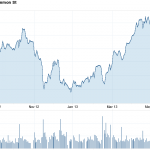 Both WTI and Brent futures moderated losses compared to last weeks plunges of 13.54% and 12.71%, respectively, as it became known that OPEC would not support prices and the market has to find its own way to recovery.
Both WTI and Brent futures moderated losses compared to last weeks plunges of 13.54% and 12.71%, respectively, as it became known that OPEC would not support prices and the market has to find its own way to recovery.
WTI crude for delivery in January on the New York Mercantile Exchange lost 1.45% on Friday to settle the week 0.5% lower at $65.84 a barrel, after prices jumped on Monday, almost offsetting the following declines. Meanwhile on the ICE, Brent January futures dropped 0.82% on Friday to close at $69.07 a barrel, registering a 1.54% weekly loss. January Brent’s premium to its US counterpart was $3.23.
Last month Oil capped its fifth consecutive loss of 18%, also the largest in six years, after the Organization of the Petroleum Exporting Countries voted against cuts in its production target of 30 million barrels a day during its official meeting in Vienna last week.
“Just when the market was thinking that a 4-year low for crude oil was bad enough, we have hit a 5-year low after the OPEC meeting,” analysts at Phillip Futures said in a note on Monday.
OPEC targeted the US shale production as it said it will stay on the side lines and wait for the market to balance out itself. However, current prices do not ensure a significant drop in US shale output.
US oil producers can win a price war against some of the OPEC members that rely heavily on high oil prices to fund their government budgets, said Harold Hamm, CEO of Continental Resources. He added that companies will have to do some cut backs and thus slow production, but a drop in activity from Texas to North Dakota won’t cause as much damage to the industry as many have projected.
Around 4% of US shale production requires a higher price than $80 per barrel to stay profitable, according to the International Energy Agency. Meanwhile, major production areas, like the Bakken formation, would still be cost-effective at below $42 a barrel. The agency also projected US supply to increase by nearly 1 million barrels a day in the next year.
Rex Tillerson, CEO of Exxon Mobil, said that the company had run tests on its profitability based on crude oil prices within the range of $40 and $120 per barrel, and he feels positive about the company’s performance even in a low oil-price environment.
According to data provided by a Reuters survey, OPEC’s twelve-member joint production dropped by 340 000 barrels per day in November as Libya’s output rebound was delayed.
However, on Wednesday Iraq announced it has reached a deal with Kurdish officials to expand exports using delivery paths through Turkey. Safeen Dizayee, a spokesman for the Kurdish Regional Government, said that OPEC’s second-biggest producer will start shipments, up to a maximum of 550 000 barrels a day, from northern Iraq to the Mediterranean port of Ceyhan, utilizing a pipeline owned by the Kurds. According to BNP Paribas, the agreement will ensure that the global oil supply surplus will remain intact.
On Friday Saudi Arabia reduced monthly crude prices in United States and Asia, further increasing speculation that the biggest OPEC oil producer is trying to defend its market share. According to a statement released by government-owned Saudi Arabian Oil, the company will offer a $2 discount, or the lowest price in more than 14 years, in Asia.
“It seems what the Saudis want, the Saudis are going to get,” said Phil Flynn, market analyst at Price Futures. “We’re going to see prices continue to be under pressure. It is still game on.”
Traders relying on technical analysis warned that the period of declines is far from over and US crude may fall to $50 per barrel, should the price break a couple of support levels. Societe Generale predicted in an e-mailed report that Brent futures will be traded at $70 per barrel in 2015 and 2016, while WTI will be exchanged at $65 as the global market will still be oversupplied. The bank’s previous forecast was $20 higher than it is now.
Crude Reserves
The Energy Information Administration reported on Wednesday that US crude oil inventories fell by 3.689 million barrels in the seven days through November 28th to 379.3 million, surpassing analysts’ expectations for a 1.75-million-barrel drop. Stockpiles at the Cushing, Oklahoma storage hub slid to 23.9 million barrels from 24.6 million a week earlier.
Refinery utilization picked up to 93.4% from 91.5% during the week through November 21st. Gasoline production decreased, while distillate fuel output increased, averaging 9.6 million and 5.0 million barrels per day, respectively.
However, this is as far as good news goes. US crude production jumped to 9.083 million barrels per day from 9.077 million, reaching the highest level on recorded weekly data dating back to January 1983. Imports slid to 7.303 million bpd, 170 000 bpd lower from a week earlier, while the four-week average of inbound shipments was 7.323 million bpd, 6.2% below year-ago levels.
Total motor gasoline inventories jumped by 2.143 million barrels to 208.6 million, exceeding analysts’ expectations for a 1.040-million jump. Distillate fuel stockpiles, which include diesel and heating oil, surged by 3.028 million barrels to 116.2 million, defying projections for a 180 000-barrel decline.
Pivot Points
According to Binary Tribune’s weekly analysis, West Texas Intermediate January futures’ central pivot point is at $66.37. In case the contract breaches the first resistance level at $69.01, it may rise to $72.19. Should the second key resistance be broken, the US benchmark may attempt to advance $74.83.
If the contract manages to breach the first key support $63.19, it might come to test $60.55. With this second key support broken, movement to the downside could continue to $57.37.
Meanwhile, January Brent’s central pivot point is projected at $69.88. The contract will see its first resistance level at $72.22. If breached, it may rise and test $75.38. In case the second key resistance is broken, the European crude benchmark may attempt to advance $77.72.
If Brent manages to penetrate the first key support at $66.72, it could continue down to test $64.38. With the second support broken, downside movement may extend to $61.22 per barrel.





